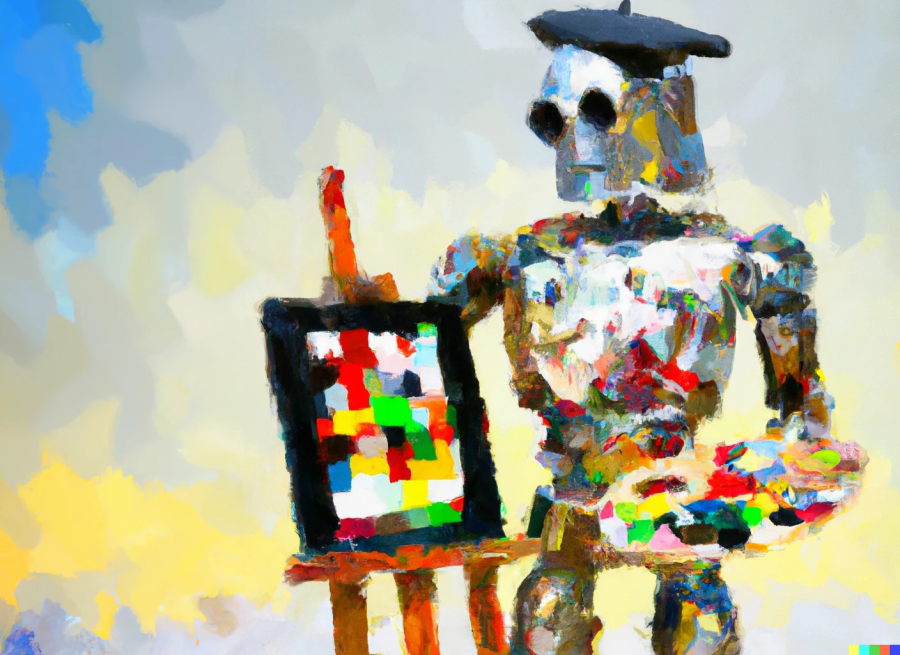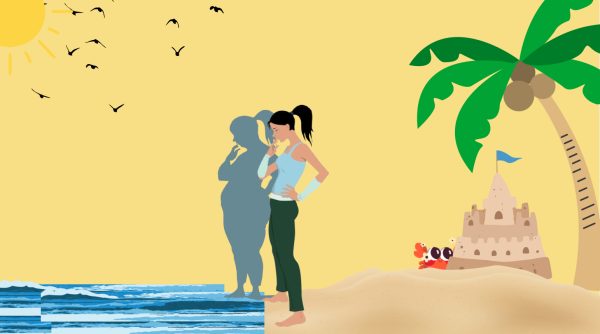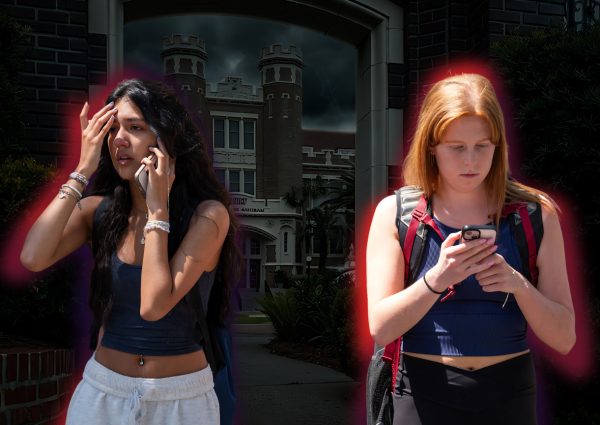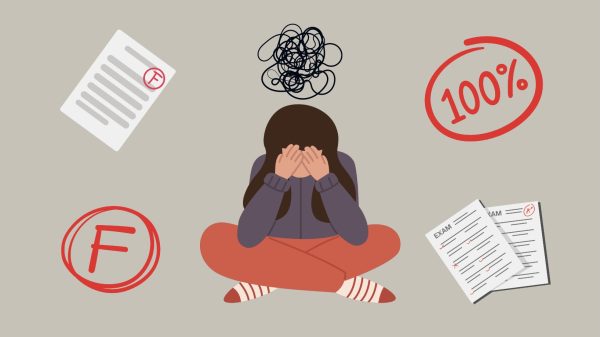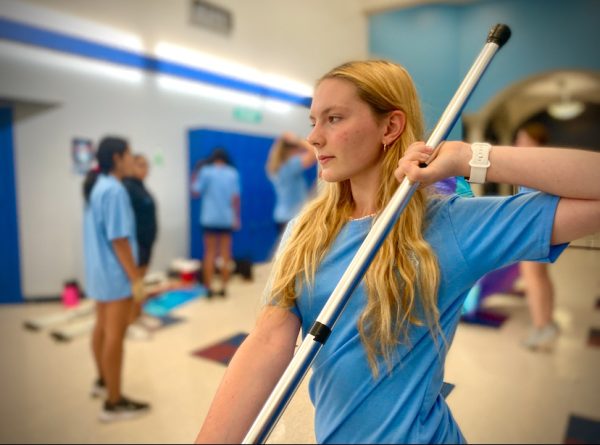Questioning AI “Art”
AI Art is rising in prominence. But is it art?
Image generated by DALL-E. Prompt: “Impressionistic painting of robot artist with paint palette”
Jason Allen took first place in the digital art category at the Colorado State Fair. His piece was generated by artificial intelligence.
Artificial intelligence describes the ability of an algorithm to mimic human behaviors. In this case, the algorithm generates unique images by learning from millions of artworks and other images. That’s where the term AI art comes from.
AI art is rising in prominence. Cosmopolitan published the first AI magazine cover. Microsoft is adding it into its software, while College Board is prohibiting students from using it. Increasing concerns are rising over its legality.
But, amid all this chaos, no one has asked whether AI art is art. “This is a personal opinion, but watching people generate AI art evokes an emotional response. It is really up to the viewer whether they perceive it as art, but it seems to be a consensus that is shared amongst many,” said CTO of Stability AI Tom Mason.
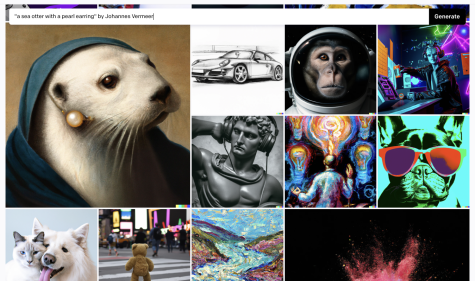
Stability AI is the company behind Stable Diffusion, a popular text-to-image model. AI only requires a prompt to create a unique image. “The act of prompt feels much like creativity. We see the same joy, satisfaction, and pleasure in creating the piece,” said Mason. “The best AI artists will develop their own understanding of styles and cultures to achieve the best outcomes.”
Programs like this are expected to influence the artistic process. “We see it as another tool in the toolbox that artists use to realize their ideas. It may become part of creative pipelines for professionals,” said Mason. “But also, simply a tool for people previously unable to draw, for instance, to feel the joy around creating images.”
AI is only improving. Stable Diffusion 2.0 was recently released, increasing resolution of generated images and allowing the upscaling of low-resolution images. “We are continually training new models and although there seems to be a breakthrough every day, we expect to see this rate increase,” said Mason.
As it increases its capabilities, its implications become an increasingly prominent point of discussion.
The Uncertain Future
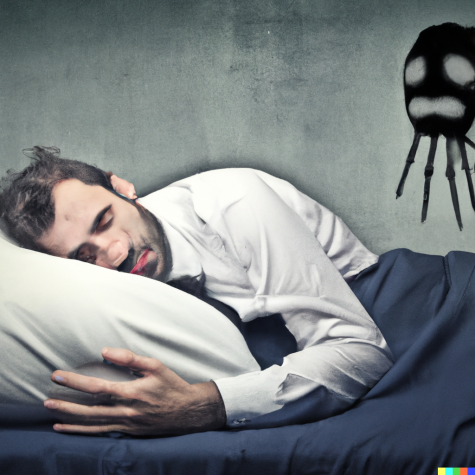
Mark Lawrence is a science fiction and fantasy writer, known for The Broken Empire trilogy. “I spent 20 or so years as a research scientist, looking into topics which all sheltered under the umbrella lay-man’s term Artificial Intelligence,” said Lawrence. “I did brush up against neural networks occasionally, and coded a couple, but it was not a serious involvement.”
Lawrence believes that AI art is art. “If someone points a camera and clicks the button, the result can hang in an art gallery. So if someone primes an AI with a prompt, the result can similarly be considered art,” said Lawrence.
Even so, he thinks AI is not yet an artist. “At the moment the art AIs are tools. Very complex, unpredictable tools, but still not artists,” said Lawrence
Eventually, however, it could be. “Certainly, if we made an AI, you could have a conversation with and believe it to be human, and then you handed it a paint brush and it made a picture, that would be art and the AI the artist,” said Lawrence.
According to Lawrence, it is impossible to determine the effects of AI art. “We’re on the outskirts of ‘interesting times. A curse or a blessing or something in between, depending on your way of looking at things. This of course depends on progress continuing, and it’s as likely to hit a wall of some kind as to accelerate,” said Lawrence. “We’ll have to muddle through like always. Let’s not give them weapons, eh?”
The New Toilet Bowl

Dave McKean is a surrealist artist. His work is broad—he’s created album covers, award-winning graphic novels, magazine illustrations, and book covers, among other endeavors. As a response to AI art, he published “Prompt: Conversations with AI,” a collection of short graphic stories.
According to McKean, the meaning of art is subjective. “All these words, art, creativity, intelligence, were created by us in a pre-AI world, in fact a pre-almost all technology world. So, it’s up to us how their definitions change as the world changes around them,” said McKean. “If we decide to include machine learned results within the definition of art then that’s how the language and culture will evolve.”
For him, AI images do not fit the current definition of art, which is fundamentally a “human activity.” “It’s a human process of understanding the world and interpreting it with our imaginations. It’s an empathy machine, it allows us to see and experience the world through each other’s eyes,” said McKean. “So, I wouldn’t call the daubings of an elephant or monkey ‘art’ either. That’s not to say they can’t be interesting phenomena in their own right, But art is the process, the thinking, the doing of the work, not just the end result.”
He believes the morality of using AI generation is an open conversation. “It’s a huge grey area that has existed in the fine art world since Duchamp put a toilet bowl in a gallery and called it art because he is an artist,” said McKean. “We now have a situation where ‘artists’ just get other people to do the work, and claim the art is in the idea, not the craft skill.”
He agrees that AI has its uses. “Is it possible to use AI as a tool, to generate ideas, imagery, raw materials that can then be folded into an artist’s work? Of course. Technology has always been part of the evolution of art, from the creation of new pigments to virtual reality,” said McKean.
But AI art on its own is fundamentally lacking. “It’s the human provoking, curating, ordering, giving context to this raw material that will or will not be judged as art,” said McKean.
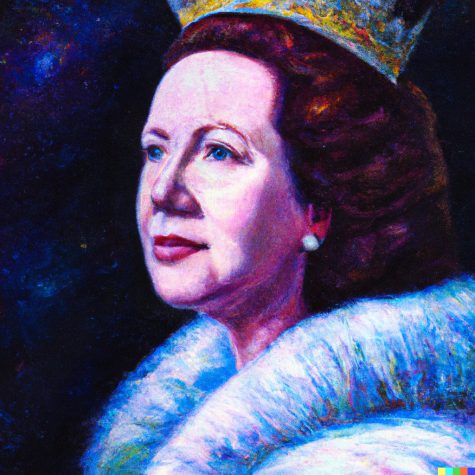
AI art remains a threat to artists. “Commercial illustration and design, production design and concept visualization. All those jobs will still be done, but if art directors and production studios can generate an infinite amount of possibilities for free, and immediately, there’s absolutely no reason to pay anyone to do a small amount of slow work at a cost,” said McKean.
Despite this, AI art has yet to master all avenues. “I’ve folded AI generated raw material into my final illustration and collage work,” said McKean. “I can’t get AI to create the kinds of close focus storytelling and expressive drawing images I use in my comics, so I’m focusing on personal work, where the train of thought and reasons why I’m doing something are crucial. Not just an infinite amount of superficial end results.”
McKean emphasizes that it is vital to have these conversations. “These things are vast experiments disrupting human life, often with fascinating new possibilities, but also with really dark and dangerous undercurrents that no one in San Francisco cares about, or thinks about until it’s too late,” said McKean.
Adapting with Technology
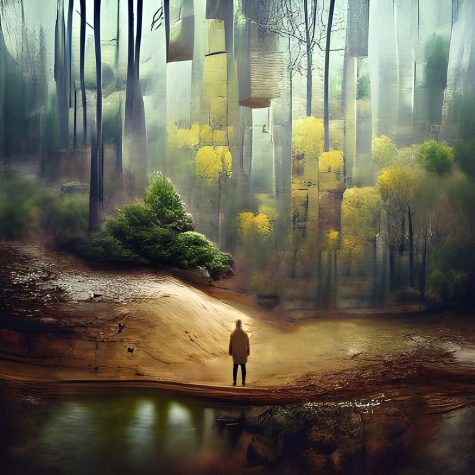
Michael Manalo is an artist who works at the convergence of digital and traditional art. He’s exhibited in several countries and received accolades for his work. AI algorithms are an integral part of his process.
Manalo agrees with McKean as to the threat AI art holds over artists. “AI art is now influencing a lot of the institutions and areas which require art–from bands to publishing houses and Youtubers,” said Manalo. “A while back, I was commissioned by the aforementioned to make art for their videos. Now, I see that they are using AI.”
He also thinks it has the potential to aid artists in several ways. “AI is a tool to create art, that should still be manually edited heavily or manipulated to be considered artwork,” said Manalo.
He offers three ways for artists to experiment with it and incorporate it into their work:
- Use it as an extension of your imagination, like a sketchbook of thoughts, colors, and inspirations from other artists. Improve on it using your own mind.
- If your work is on the internet, AI has likely studied it. See what it can create using your work as the basis of inspiration.
- Expand or extend your images, with programs like DALL-E 2. Break barriers and get out of your comfort zone.
A Visit to the Studio
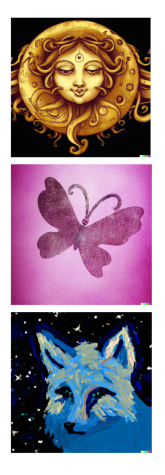
Art students sit at tables and work on their projects. Ceramicists sculpt carefully and illustrators perfect their hand-drawn pieces. That solitude is disrupted as a laptop is passed around, with a text-to-image generator open.
Senior Yusra Syed used the generator first. She input the prompt “beautiful sun and moon goddess.”
“It’s fed information, and spits stuff out,” said Syed. “DALL-E steals its image derivations from other artists. People use the prompts and claim the artworks entirely as their own. It exploits the time and effort genuine artists use to make art.”
Senior Madison Rousseau disagreed with Syed.
“It is real art. Anything created can be art. Effort doesn’t matter,” said Rousseau. “Even if you steal someone’s art, and trace over it, it’s still art.”
Senior Karina Walsh believes the issue is more complex.
“I wouldn’t say it has more value than made art. There’s a way that humans can make things that AI can’t really replicate. Typing a prompt doesn’t make you an artist,” said Walsh.
Freshman Nyla Escalona tried the generator next—her prompt was “pink butterfly.”
“I’m not sure if its art. Art is something that is created. It is created, but I don’t know if it did with a purpose or not. And that’s what part of art is,” said Escalona.
Junior Kiyoshi Proverbs has a more detailed prompt in mind. She types “a painting of a fox in the style of Starry Night.”
“Technically, its art. Art can be whatever you want it to be,” said Proverbs.
Pandora’s Box

Of everyone in the studio, art teacher Lauren Lindsay puts it best. “It’s out there,” said Lindsay, shrugging.
Capabilities of AI will only expand as time goes on. Already, AI can code itself and write essays.
“The nature of models across different modalities such as image, audio, video and 3D is going to become a central part of the future creative toolset,” said Mason.
Whether it is or isn’t art, AI image generation is here to stay. Discussing it is crucial.
“It’s important to go into these areas with our eyes open, and push back against the worst, most irresponsible aspects of the technology. At the moment, we have a voice. We need to be heard,” said McKean.
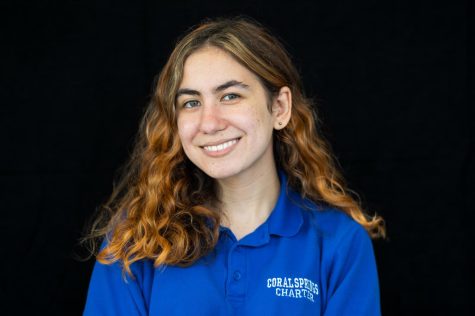
Madalen Erez is a senior. This is her fourth year on staff. In her free time, she enjoys reading fantasy novels and taking photos of nature.

